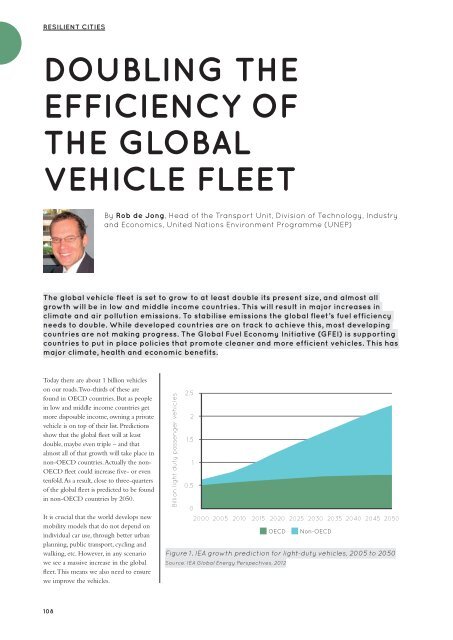Climate Action 2014-2015
Create successful ePaper yourself
Turn your PDF publications into a flip-book with our unique Google optimized e-Paper software.
RESILIENT CITIES<br />
DOUBLING THE<br />
EFFICIENCY OF<br />
THE GLOBAL<br />
VEHICLE FLEET<br />
By Rob de Jong, Head of the Transport Unit, Division of Technology, Industry<br />
and Economics, United Nations Environment Programme (UNEP)<br />
The global vehicle fleet is set to grow to at least double its present size, and almost all<br />
growth will be in low and middle income countries. This will result in major increases in<br />
climate and air pollution emissions. To stabilise emissions the global fleet’s fuel efficiency<br />
needs to double. While developed countries are on track to achieve this, most developing<br />
countries are not making progress. The Global Fuel Economy Initiative (GFEI) is supporting<br />
countries to put in place policies that promote cleaner and more efficient vehicles. This has<br />
major climate, health and economic benefits.<br />
Today there are about 1 billion vehicles<br />
on our roads. Two-thirds of these are<br />
found in OECD countries. But as people<br />
in low and middle income countries get<br />
more disposable income, owning a private<br />
vehicle is on top of their list. Predictions<br />
show that the global fleet will at least<br />
double, maybe even triple – and that<br />
almost all of that growth will take place in<br />
non-OECD countries. Actually the non-<br />
OECD fleet could increase five- or even<br />
tenfold. As a result, close to three-quarters<br />
of the global fleet is predicted to be found<br />
in non-OECD countries by 2050.<br />
It is crucial that the world develops new<br />
mobility models that do not depend on<br />
individual car use, through better urban<br />
planning, public transport, cycling and<br />
walking, etc. However, in any scenario<br />
we see a massive increase in the global<br />
fleet. This means we also need to ensure<br />
we improve the vehicles.<br />
Billion light duty passenger vehicles<br />
2.5<br />
2<br />
1.5<br />
1<br />
0.5<br />
0<br />
2000 2005 2010 <strong>2015</strong> 2020 2025 2030 2035 2040 2045 2050<br />
OECD Non-OECD<br />
Figure 1. IEA growth prediction for light-duty vehicles, 2005 to 2050<br />
Source: IEA Global Energy Perspectives, 2012<br />
108












